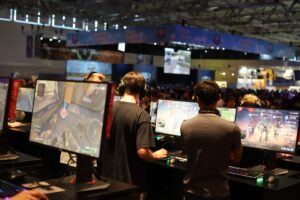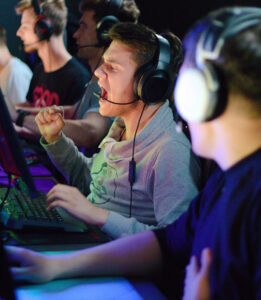Don’t miss out on part 1 of ‘The rise and rise of eSports’, where Dhaval Ponda gives the context as to why the gaming phenomenon has become so important to broadcasters.
Previously, I wrote about the immense rise of eSports through the likes of Youtube, Twitch and Mixer, and also some of the the challenges and barriers the industry faces including the lack in superior connectivity, the complexities in media rights ownership, and the need for a lean and cost-efficient business model. But with challenges there’s always solutions and the opportunities for broadcasters makes them worth finding.
A lesson from South Korea
As always, there is a lot to be considered. On one hand there is a need for achieving scale, efficiency and customer delight and on the other, there is a need for ensuring revenue balances out the costs of these events.
“South Korea is one country that has embraced eSports and made moves to integrate the industry as an intrinsic cultural trend; tapping into new fans and enhancing the experience of current fans.”
A lot of this has stemmed from within the industry itself but more traditional sports could learn from this.
 In Seoul, there is a dedicated eSports stadium, Nexon Arena, which has hosted eSports events since 2013. Founded by its namesake, a South Korean gaming company, the stadium hosts events for multiple games including StarCraft II and League of Legends. Unlike other sports, there is no traditional stadium format, this changes all the time and the infrastructure within the stadium has to be flexible to accommodate this.
In Seoul, there is a dedicated eSports stadium, Nexon Arena, which has hosted eSports events since 2013. Founded by its namesake, a South Korean gaming company, the stadium hosts events for multiple games including StarCraft II and League of Legends. Unlike other sports, there is no traditional stadium format, this changes all the time and the infrastructure within the stadium has to be flexible to accommodate this.
There is a dedicated eSports channel, OGN, pioneering the new way eSports is seen. OGN stemmed from one program following the rise in popularity of StarCraft in South Korea and progressed to a stand-alone channel estimated to spend upwards of $100 million each year to broadcast and produce live eSport events. They’re now looking towards the North American market.
A governing body, Korean eSports Association, has been established to regulate and manage the competitive side of the sport and it’s a member of the Korean Olympic Society – a sure-fire sign of how seriously it’s taken in the country, compared with elsewhere.
“While the technology which can make all of this possible exists in theory, the infrastructure in other global cities doesn’t yet exist to the scale this fast-growing sport needs.”
South Korea tops the international table of internet speeds with an average of 26MBps. High speed internet is invaluable for gamers – it stops lag and therefore gives them the competitive edge. Additionally, its widespread broadband infrastructure means 90% of its population are internet users, therefore more people are likely playing.
The road ahead
 In South Korea, eSports has already woven itself into the mainstream and it’s catching up fast in other countries. London Premier League Club, Tottenham Hot Spurs, will be hosting eSports at its new stadium this year, Reuters has created an eSports Wire and what may be astounding to some, a number of universities across the US are starting to offer eSports scholarships. When the topic is so exciting and such a game changer for the future, it is impossible to resist some crystal ball-gazing.
In South Korea, eSports has already woven itself into the mainstream and it’s catching up fast in other countries. London Premier League Club, Tottenham Hot Spurs, will be hosting eSports at its new stadium this year, Reuters has created an eSports Wire and what may be astounding to some, a number of universities across the US are starting to offer eSports scholarships. When the topic is so exciting and such a game changer for the future, it is impossible to resist some crystal ball-gazing.
Big data and AI machine learning: Traditional sports are not just about practice, they’re also based on strategy and analytics. More than others, eSports is built for deep data analysis. Using AI machine learning, the industry and players themselves can track how they play and use the analytics to improve their play, track their competitors and change the gaming experience to something more customised.
“And not just improving play, AI can be used to meet the ever-increasing demand for highlights and conversations – ensuring that “best bits” can be pulled together almost instantly and used to engage fans in real time, and specific to their interests with tailored packages.”
This will also mean that technology and analytics will uncover many new pricing models and opportunities for additional revenue streams, for example team analysis in franchised leagues to ensure there will be a worthwhile ROI. It will serve as a guide for investors and brands which will evolve into more lucrative deals – not unlike how YouTube evolved over the past few years.
Celeb status growth: The old view of a gamer as an awkward teen in his room is gone, players are now appreciated for the talent, skill and commitment it takes to get to the top. Even pros in traditional sports like Formula 1 star Lando Norris cites eSports as a key contributor to him learning his craft. Using the human stories from the players and their social media presence has the ability to get deeper fan engagement.
Olympic Games: Despite it not being on the list yet, it’s looking likely to be credited as an Olympic Sport in the coming years, predicted to be in action at Paris 2024. This will see it garnering an even bigger widespread appeal and respectability.
Ultimately the money doesn’t lie. The predicted growth rate and rapidly rising prize pots indicate that eSports is only set to get bigger. This is a classic case of audience demand, creating gaps in the market for us to fill, by expanding our own industries and collaborating with new partners. And while there are challenges ahead, the potential opportunities for the broadcasting industry are vast.
Read more about the potential for broadcasters in the eSports industry in part 1 of The rise and rise of eSports: the new media industry favourite.
Transformational Hybrid SolutionsOur cloud-enablement services offer the best performance on your traffic-heavy websites or mission-critical applications.
Core NetworksTata Communications™ global IT infrastructure and fibre network delivers the resources you need, when and where you need them.
Network Resources
Unified Communications As A ServiceBreak the barriers of borders efficiently and increase productivity with Tata Communications’ UC&C solutions.
Global SIP ConnectEmpower your business with our SIP network and witness it grow exponentially.
InstaCC™ - Contact Centre As A ServiceCloud contact centre solutions for digital customers experience and agent productivity.
Unified Communication Resources Case studies, industry papers and other interesting content to help you explore our unified communications solution better.
IoT SolutionsThe Internet of Things is transforming the way we experience the world around us for good. Find out more about our Internet Of Things related solutions here.
Mobility SolutionsTata Communications’ mobility services enable your enterprise to maintain seamless communication across borders, with complete visibility of cost and usage.
Mobility & IoT Resources
Multi-Cloud SolutionsWith enterprises transitioning to a hybrid multi-cloud infrastructure, getting the right deployment model that yields ROI can be a daunting task.
Cloud ComplianceCompliant with data privacy standards across different countries and is also designed to protect customers’ privacy at all levels.
IZO™ Cloud Platform & ServicesIZO™ is a flexible, one-stop cloud enablement platform designed to help you navigate complexity for more agile business performance.
Managed Infrastructure ServicesIntegrated with our integrated Tier-1 network to help your business grow efficiently across borders.
Cloud PartnersWe support a global ecosystem for seamless, secure connectivity to multiple solutions through a single provider.
Cloud Resources
Governance, Risk, and ComplianceRisk and Threat management services to reduce security thefts across your business and improve overall efficiencies and costs.
Cloud SecurityBest-in-class security by our global secure web gateway helps provide visibility and control of users inside and outside the office.
Threat Management - SOCIndustry-leading threat-management service to minimise risk, with an efficient global solution against emerging security breaches and attacks.
Advanced Network SecurityManaged security services for a predictive and proactive range of solutions, driving visibility and context to prevent attacks.
Cyber Security ResourcesCase studies, industry papers and other interesting content to help you explore our securtiy solution better.
Hosted & Managed ServicesTata Communications provide new models for efficient wholesale carrier voice service management. With our managed hosting services make your voice business more efficient and better protected
Wholesale Voice Transport & Termination ServicesYour long-distance international voice traffic is in good hands. End-to-end, voice access & carrier services which includes voice transport and termination with a trusted, global partner.
Voice Access ServicesTata Communication’s provide solutions which take care of your carrier & voice services, from conferencing to call centre or business support applications.
Carrier Services Resources
CDN Acceleration ServicesOur CDN Web Site Acceleration (WSA) solution helps deliver static and dynamic content, guaranteeing higher performance for your website.
CDN SecuritySafeguard your website data and customers’ information by securing your website from hacks and other mala fide cyber activities.
Video CDNDeliver high-quality video content to your customers across platforms – website, app and OTT delivery.
CDN Resources
Elevate CXIncrease customer satisfaction while empowering your service team to deliver world-class customer experience and engagement.
Live Event ServicesTata Communications’ live event services help battle the share if eyeballs as on-demand video drives an explosion of diverse content available on tap for a global audience.
Media Cloud Infrastructure ServicesTata Communications’ media cloud infrastructure offers flexible storage & compute services to build custom media applications.
Global Media NetworkTata Communications’ global media network combines our expertise as a global tier-1 connectivity provider with our end-to-end media ecosystem.
Use CasesUse cases of Tata Communications’ Media Entertainment Services
Remote Production SolutionsMedia contribution, preparation and distribution are highly capital-intensive for producers of live TV and video content, and their workflows are complex.
Media Cloud Ecosystem SolutionsThe Tata Communications media cloud infrastructure services offer the basic building blocks for a cloud infrastructure-as-a-service.
Global Contribution & Distribution SolutionsTata Communications’ global contribution and distribution solution is built to reduce capital outlay and grow global footprint.
Satellite Alternative SolutionsAs more and more consumers choose to cut the cord & switch to internet-based entertainment options, broadcasters are faced with capital allocation decisions.
LeadershipA look into the pillars of Tata communications who carry the torch and are living embodiment of Tata’s values and ethos.
Culture & DiversityHere at Tata Communications we are committed to creating a culture of openness, curiosity and learning. We also believe in driving an extra mile to recognize new talent and cultivate skills.
OfficesA list of Tata Communications office locations worldwide.
FAQCheck out our FAQs section for more information.
SustainabilityOur holistic sustainability strategy is grounded in the pillars of People, Planet and Community with corporate governance at the heart of it.
BoardHave a look at our board of members.
ResultsFind out more about our quarterly results.
Investor PresentationsFollow our repository of investor presentations.
FilingsGet all information regarding filings of Tata communications in one place.
Investor EventsAll investor related event schedule and information at one place.
GovernanceAt Tata, we believe in following our corporate social responsibility which is why we have set up a team for corporate governance.
SharesGet a better understanding of our shares, dividends etc.
SupportGet all investor related contact information here.


